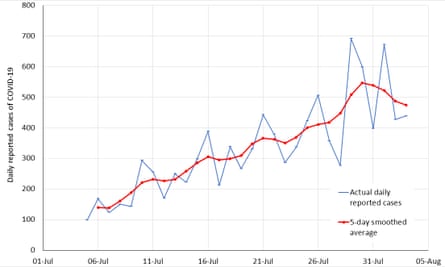‘We know that hard lockdowns work’
As of 2 August Australia had been experiencing average rates (smoothed over five days given how fluctuating daily counts are) of 500 to 600 per day in Victoria – although we may have just passed the peak with numbers perhaps beginning to fall in the last few days. But we still have a long way to go.
Moreover, there are anywhere between 50 to 100 “mystery” cases a day – those cases that pop up and you can’t work out where they got it from. They are concerning, as it means transmission has gone “underground” in asymptomatic cases, and it reflects out-of-control community infection. Meanwhile, New South Wales and Queensland, teetering on the precipice of community transmission, are flaring up.
We know masks are effective. Interestingly, the five day average in the graph below peaks at seven days after masks became mandatory, which is exactly what would be expected.

So Victoria is in stage four. We are not allowed to go out of the home more than once a day, and no more than 5km to shop for essentials only. There is even a curfew from 8pm to 5am – perhaps the premier’s way of telling us “this is serious”.
Is elimination even achievable now? It is not a hard argument to run that the virus has got its hooks into too many nooks and crannies in Victoria to easily dislodge. True, it is not going to be easy. But we also know that hard lockdowns work.
The case numbers, surely, will fall. And if we stay in stage four lockdown, we will eventually eliminate community transmission. The question is how long Victoria would have to stay in stage four to achieve this. We do not know the answer to this question yet. Perhaps in two to three weeks, we might have enough data to model it or hazard a guess. The issue will then become whether achieving elimination of community transmission is worth the economic and social costs of a stage four lockdown.
Numbers being thrown around at the moment are of a six-week hard lockdown costing Victoria and the country about $9bn. Such costs are high. But so too is the cost of not eliminating the virus, and having to live in a spluttering economy – going in and out of lockdown – until a vaccine hopefully arrives.
• Tony Blakely is a professor of epidemiology at the University of Melbourne.
‘In New Zealand, clear consistent messaging has been key’
A New Zealand-style lockdown is likely to give the state government of Victoria a reasonable chance of eliminating community transmission of the Covid-19 virus. This was the approach a group of Australian and New Zealand researchers recommended in the Medical Journal of Australia two weeks ago. It is also what the Victorian president of the Australian Medical Association has been arguing for repeatedly. The effectiveness of a short, intense lockdown is graphically illustrated on the Oxford University Our World in Data website. The New Zealand lockdown was implemented on 26 March, at a similar time to Australia, but was much stronger (up to 96.3% on their stringency scale) compared with Australia (75.9%). In New Zealand the lockdown (effectively a “stay-at-home order”) ended on 14 May and the country then moved steadily back to near-normal operations. However, in Australia, various lockdown restrictions have remained in place in many states.
A stringent lockdown must have as few exemptions as possible so that it is unambiguous and enforceable. People can only leave their homes for essentials (food, healthcare and physical activity). Essential workers need to be a tightly defined group (as they were in New Zealand during its lockdown), allowing basic functioning of society to continue. Risks can be further minimised if there is mask use in all public settings.
To get everyone on board there needs to be clear government messaging around the elimination goal. In New Zealand, clear consistent messaging has been a key factor in creating and maintain public trust in government directives to adhere to lockdown measures. It would help if the Australian federal government pledged more resources to help Victoria and to also support elimination in New South Wales. Such a joined-up approach is critical as then internal state border controls can be removed. This success would then allow ideas like quarantine-free travel bubbles to be explored with other Covid-19-free jurisdictions such as New Zealand, Taiwan and various Pacific Islands.
Government support is needed to minimise the lockdown’s economic impacts on small businesses – and here the New Zealand experience is also relevant. Because it achieved elimination fairly quickly, there seems to have been a much more rapid economic recovery in New Zealand than Australia (see payroll data comparisons in our work). Even ongoing community transmission at a low level with the risk of long-term restrictions and setbacks may be particularly bad for business confidence. As with the health impacts, a more stringent lockdown that achieves successful elimination might be the best long-term economic strategy as well.
• Michael Baker and Nick Wilson are professors of public health at the University of Otago
The Link LonkAugust 04, 2020 at 09:12AM
https://www.theguardian.com/commentisfree/2020/aug/04/its-not-going-to-be-easy-experts-on-what-australia-must-do-to-curb-covids-spread
'It's not going to be easy': experts on what Australia must do to curb Covid's spread - The Guardian
https://news.google.com/search?q=easy&hl=en-US&gl=US&ceid=US:en
No comments:
Post a Comment